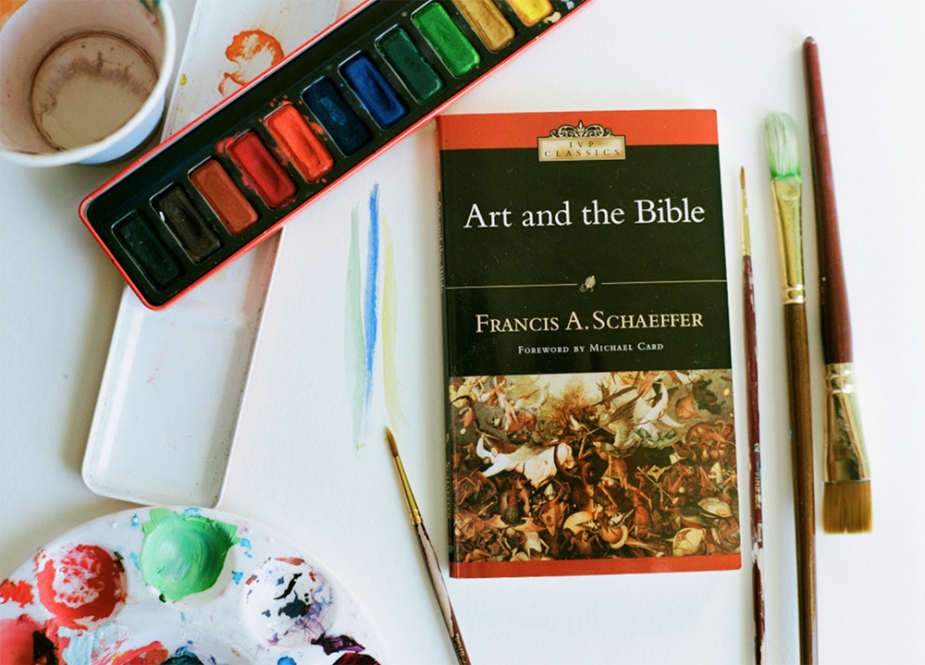Art and The Bible by Francis A. Schaeffer gives an interesting, very intellectual perspective on where art stands in the Christian mindset and lifestyle. It addresses many misinterpretations and questions of what God says and feels about art and the making of it.
The foreword begins with a bit of a history lesson, to give us perspective on the need of a clear understanding of Art and Christianity; what is of God and what is only for the glory of Man. This book approaches the Bible, yes, as a Holy Book, but also a book that is grounded in the reality they lived in back then and today. What I mean by this is, it addresses the spiritual realities, as well as the physical (something I feel is often forgotten). At one point in the book, the author said, "The Bible addresses the whole Man, just as God created them." This means that it is true that logic and thought can be put into the things of the Bible, even the spiritual things. Of course, we can't understand everything; we are finite while our God is infinite. But this doesn't mean we should be discouraged from thinking. Not thinking purely to know something more; knowledge's sake, but to help us to understand our Father in Heaven on a deeper level. God has given us brains, after all. It is that the mind has been corrupted by sin and must be rewired back to its original state, that is, before the Fall of Man.
Where is the value in creativity? The author answers these questions. Firstly the fact that God is the Creator gives creating value already. Schaeffer continues, stating that there are three main views of art.
Number 1: Just art for art's sake; it's just there to be there. It doesn't say and it's not suppose to say anything. Schaeffer questions, does any great artist work from this point of view? He used the artists of the Renaissance and Modern artist like, Picasso to explain how all legendary artist wished to communicate something. The point being that the great masters never worked with this mindset.
Number 2: Art is a vehicle which to communicate a message about the world, artist, man etc. To be honest, this is the view I had about art for a while. The author goes on explaining how this way of thinking only reduces art to "an intellectual statement" and the idea of art for art's sake disappears.
Number 3: In which the artist creates something displaying their worldview. Great artists began by creating a work of art and then worldview naturally shows through their body of work. Schaeffer emphasizes "body of work" because he believes no single piece of work can display a person's full worldview. From Michelangelo's body of work, critics and art professionals can say and learn something about Michelangelo, himself. This view the author holds as his favorite.
So what's God's problem with art? In summary, the book explains in many ways that it's not that God dislikes art or people creating, but it's the way it is used. Because of the sin of Man, art (just like many other things) can be used to sin when it was intended for good. Just as we were made "very good" (as said by God), but then became sinful after the Fall. According to the author, a body of art displays the worldview of the artist and the worldview of Man is skewed because of sin. This doesn't make art inherently bad, but how we use it in important. Art doesn't even have to be strictly Biblical. Schaeffer goes into great detail explaining this using many verse within the Word of God.
The way I often saw Art and how it affects and works with my faith first came to me when I was young and still living with my family. At the time, we lived on a large hill so every morning there would be a glorious sunrise and in the evening, a beautiful sunset. Every single day, each sunrise and sunset were different from one another and the thought suddenly came to me, "How many thousands of unique sunrises and sunsets had God created before I was and intend to create afterwards?" I often described the sky as God's canvas. And isn't it true? Each day brings a different sky. Though some skies may have similarities with others, no two skies are exactly the same. At that time this thought gave my art some validation. It also helped me feel a bit closer to God emotionally and helped me to understand Him more. Before I knew anything about this God that created everything with so much love, as soon as the Creator and Creative God was revealed to me more deeply, I felt that this God must care about the things He created. After all, I cared about my creations, even when they weren't that great.
Through out the Bible, it speaks of God's great love for this Earth and most of all His children. This concept of an unconditional, unfathomable love is often difficult for many to understand or accept. If you find yourself at that place, just take a moment to look at that sunrise, sunset or even nature itself. A picture is worth a thousand words, right? Just look around you, at the beauty of God's creation. I have the luxury of being in the countryside currently so I can so easily see, but for those of you who are in the city or in a place where God's nature isn't so easily seen, look deeper. Look at the people passing by. Though corrupted by sin, within every Man God as put something beautiful. And see the way the bodies function. All of these everyday things people around you do was skillfully made to function in these ways. Isn't this beautiful? And finally if you find yourself not in nature, not surrounded by people but alone, get up and walk to a mirror. God loves the person in that image. No matter who you are or what you've done, God created you, right? Step back and think about that for a moment. I was created. Every separate entity within me and outside of my control was planned out and created to have me function and live. God didn't make us think in order to breathe, He made it natural; an instinct.
A picture is worth a thousand words and we must look at the picture deeply in order to understand everything He wants us to know. About Him and about ourselves.




